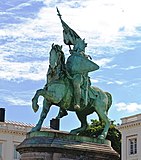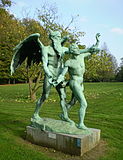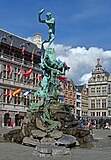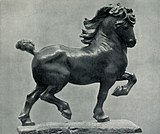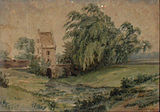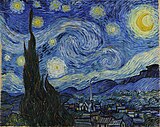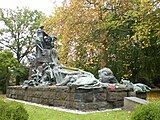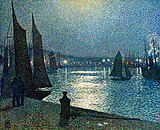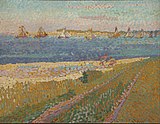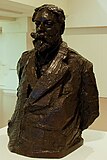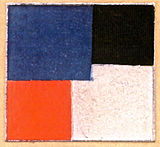Royal Academy of Fine Arts, Brussels
 Entrance of the Royal Academy of Fine Arts, Rue du Midi/Zuidstraat, Brussels | |
| Type | Art school |
|---|---|
| Established | 1711 |
| Location | , Belgium 50°50′38″N 4°20′52″E / 50.8440°N 4.3477°E |
| Website | arba-esa |
The Royal Academy of Fine Arts of Brussels (French: Académie royale des Beaux-Arts de Bruxelles - École supérieure des Arts (ARBA-ESA); Dutch: Koninklijke Academie voor Schone Kunsten van Brussel) is an art school in Brussels, Belgium, founded in 1711. Starting from modest beginnings in a single room in Brussels' Town Hall, it has since 1876 been operating from a former convent and orphanage in the Rue du Midi/Zuidstraat, which was converted by the architect Victor Jamaer. The school has played an important role in training leading local artists.[1]
History[edit]
Origins[edit]

Historically, artistic training in Brussels was organised in traditional workshops where masters would teach their skills to pupils. The masters needed to be registered with their local guild to be able to practice their craft. On 30 September 1711, the magistrate of the City of Brussels gave the guilds of painters, sculptors, weavers and other amateurs the use of a room in Brussels' Town Hall to teach drawing classes to their pupils. On 16 October of the same year, some sort of school was established at these premises to organise the classes. The school would concentrate mainly on teaching drawing.[2]
In 1737, the Academy adopted its first rules. The city assumed some costs, including those for the models. A few decades later, disagreement broke out. The classes moved to the inn 't Gulden Hoofd and were even suspended for a while. The Bruges painter Bernard Verschoot took over the Academy's leadership and tried to put it back on the rails with a heavy hand. The Governor of the Habsburg Netherlands, Prince Charles Alexander of Lorraine, put the school under his high protection in 1762. His attention went mainly to the Department of Architecture. The school was re-established in 1768 as the Académie de Peinture, Sculpture et Architecture ("Academy of Painting, Sculpture and Architecture"), with funds raised through a public subscription. Inspiration was found in the French model. A year later, the school returned to the Town Hall. In 1795, the Academy was closed after the conquest of Brussels by French revolutionary troops.
[edit]
In 1829, the school moved into the Granvelle Palace (since demolished). One year later, François-Joseph Navez became director. He organized the school and expanded it. In 1832, it moved to the basement of the left wing of the Industrial Palace. From 1835 to 1836, Navez's plans were implemented. In 1836, the Academy was awarded the privilege to use the adjective "Royal" as part of its name. The panel painting was declared to another important department. It was based on the first golden age of Dutch painting. However, there was some time tensions at the Academy to the yet propagated neoclassical style. In addition to painting and sculpture, architectural education became more important, though it never achieved the status of a pioneering teaching and training facility.[3]

In 1876, the Academy moved to the school buildings on the Rue du Midi/Zuidstraat, in what was the former Bogards' convent, which had meanwhile served as an orphanage. The architect Victor Jamaer was able to link the whole school in the limited space of the existing ensemble. The facade was redesigned in the neoclassical style. Until today the academy is there. From 5 January 1889 women were also allowed to participate in a class for advanced students.[4] At the end of the 19th century, was the founding of the modern LUCA Campus Sint-Lukas Brussels, a strong competition. Meanwhile, ARBA is one of the 16 art schools of the French Community of Belgium. Under the director Charles van der Stappen, the doctrine came to this university to an even greater prestige. Even literature and photography were part of the training offer.
In the European art scene around the turn of the century, Brussels drew forth in addition to his training center in the shadow of Paris.[5] Since 1889, Brussels was the uncrowned capital of Art Nouveau, especially in architecture, which had its triumphal procession through Prof. Victor Horta.[6] The Academy managed the step to another center of the avant-garde in the panel painting. From the Academy and its students went influence on the development of Realism, Symbolism, Impressionism, Neo-Impressionism, Post Impressionism and the newly incipient Expressionism. These were all precursors of Modern Art.

In 1912, Horta had made changes to the organisation of the school. A system of studios was created, as it was recommended by Paul Bonduelle and Émile Lambot.[7][8][9] In 1936, the Royal Order was made to the formation of the separate Department of Architecture.
Changes in organization and teaching after 1945[edit]
In 1949, a small Department of Planning and Urban Development was established. Architectural studies got the rank of university education. In 1972, the Department of Artistic Humanities was established. In 1977, the Department of Architecture finally acquired its autonomy. In 1977, the Institute Supérieur d'Architecture Victor Horta, named after the Art Nouveau architect and former director, was founded. In 1980, the higher education of the second degree and new courses at the Academy of Fine Arts were presented. In 2009, the Faculty of Architecture of the Free University of Brussels was founded. This was done after the merger of the two schools of architecture: the School of Architecture Victor Horta (ISAVH) and the chamber of the French Community of the Higher Institute of Architecture (ISACF).
Nowadays, programs are offered for Bachelor of Arts and Master of Arts in the fields of design, art and media and offered doctoral studies, too. The Academy has been an ESA (Ecole Supérieure des Arts - Art College) with a university orientation. In addition, it is part of Royal Academies for Science and the Arts of Belgium (RASAB) which was founded in 2001. It is responsible for the task of promoting activities of the affiliated members and organizations here and coordinate. Its tasks include projects at home and abroad. The school is sometimes confused with the Royal Academies for Science and the Arts of Belgium (RASAB) and the Royal Academy of Science, Letters and Fine Arts of Belgium, both separate institutions, as well as the French Académie des Beaux-Arts in Paris, part of the Institut de France.
The faculty and alumni of ARBA[edit]
Includes some of the most famous names in Belgian painting, sculpture, and architecture:
- James Ensor (1860–1949), painter and printmaker
- Paul Delvaux (1897–1994), surrealist painter
- René Magritte (1898–1967), surrealist painter
- Kali (1918–1998), Polish-American painter
- Peyo (1928–1992), cartoonist, creator of The Smurfs
- Oriane Lassus (b. 1987), French author, cartoonist and illustrator
Notable directors and professors[edit]
- Barnabé Guimard (1731–1805), French architect
- Tilman-François Suys (1783–1861), architect
- François-Joseph Navez (1787–1869), neoclassical painter
- Louis Gallait (1810–1887), painter
- Eugène Simonis (1810–1893), sculptor
- Jean-François Portaels (1818–1895), painter
- Charles van der Stappen (1843–1910), sculptor
- Jef Lambeaux (1852–1908), sculptor
- Jacques de Lalaing (1858–1917), Belgian-British sculptor and painter
- Victor Horta (1861–1947), architect
- Paul Saintenoy (1862–1952), architect, teacher, architectural historian, and writer
- Henri van Dievoet (1869–1931), architect
- Alfred Bastien (1873–1955), artist, academic, and soldier
- Léon Devos (1897–1974), painter[10][11]
Gallery of works by notable teachers and directors[edit]
-
Tilman-François Suys (date unknown): St. Antonius Church, Amsterdam.
-
François Joseph Navez (1828): Travelling Musicians, National Galleries of Scotland.
-
Eugène Simonis (1848): Equestian statue of Godfrey of Bouillon, Place Royale/Koningsplein, Brussels.
-
Louis Gallait (1848): The family of the fisherman, Hermitage Museum, St. Petersburg.
-
Alexandre Robert (date unknown), Young page, Private collection.
-
Joseph Quinaux (date unknown): The rest, Private collection.
-
Jean-François Portaels (date unknown): Sweet flowers, Private collection.
-
Joseph Stallaert (date unknown): The prophet Jeremiah prophesies the fall of Jerusalem, Private collection.
-
Herman Richir (date unknown): The sleep of Jamilé, Private collection.
-
Victor Horta (1892/93): Hôtel Tassel, Brussels.
-
Constant Montald (1893): Ophelia, Private collection.
-
Charles Van der Stappen (1894/98): Time, Meise Botanic Garden.
-
Victor Horta (1898/1900): Hôtel van Eetvelde, Brussels.
-
Victor Horta (1898/1900): Hôtel Solvay, Avenue Louise/Louizalaan 81, Brussels.
-
Jef Lambeaux (date unknown): Brabo Fountain, Antwerp.
-
Victor Horta (1901): À L'Innovation department store, Rue Neuve/Nieuwstraat, Brussels.
-
Victor Horta (1903/05): Le Grand Bazar department store, Frankfurt.
-
Jacques de Lalaing (date unknown): Brabantine horse.
-
Alfred Theodore Joseph Bastien (date unknown): Canadian Cavalry Ready in a Wood, Canadian War Museum, Ottawa.
-
Alfred Theodore Joseph Bastien (1918): Grenade throwing, Canadian War Museum, Ottawa.
-
Henry Lacoste (date unknown): St. Theodardus Church, Beringen-Mijn.
Notable students[edit]
- Joseph-Pierre Braemt (1796–1864), medalist
- François Musin (1820–1888), painter
- Franz Meerts (1836–1896), painter
- Josse Impens (1840–1905), painter
- Gustave Léonard de Jonghe (1844–1848), painter
- Emile Wauters (1846–1933), painter
- Isidore Verheyden (1846–1905), painter
- Alfred Verhaeren (1849–1924), painter
- Amédée Lynen (1852–1938), painter and illustrator
- Vincent van Gogh (1853–1890), Dutch painter
- Jan Hillebrand Wijsmuller (1855–1925), Dutch painter
- Paul Du Bois (1859–1938), French sculptor
- James Ensor (1860–1949), painter
- Victor Rousseau (1865–1954), sculptor
- Jef Leempoels (1867–1935), painter
- Gabriel Van Dievoet (1875–1934), painter
- Victor Servranckx (1897–1965), painter
- Paul Delvaux (1897–1994), painter
- René Magritte (1898–1967), painter
- Éliane de Meuse (1899–1993), painter
- Claudia Cobizev (1905-1995), Moldovan sculptor
- Zhang Chongren, better known as Tschang Tschong-jen (1907–1998), Chinese sculptor and painter
- Ben-Ami Shulman, (1907–1986), Israeli architect
- Claude Strebelle (1917–2010), architect and builder[12][13]
Gallery of works by notable students[edit]
-
Joseph Poelaert (date unknown): New building of St. Catherine's Church, Brussels.
-
Jean-Frédéric Van der Rit (1856): Tomb of Augustus dal Pozzo at the Church of Our Blessed Lady of the Sablon, Brussels.
-
Charles de Groux (1856/57): The farewell.
-
Franz Meerts (date unknown): At the café, Private collection
-
Guillaume Vogels (date unknown): Fishing boat on the shore, Private collection.
-
Emile Wauters (date unknown): Caravan near Cairo, Private collection.
-
Gustave Léonard de Jonghe (1865): The Japanese Fan, Cummer Museum of Art and Gardens.
-
Isidore Verheyden (date unknown): Return from the market, Museum M, Leuven.
-
August Félix Schoy (1865): Restoration of the Church of Our Blessed Lady of the Sablon, Brussels.
-
Hippolyte Boulenger (1870): View of Dinant, Royal Museum of Fine Arts of Belgium, Brussels.
-
Amadée Lynen (after 1872): Landscape with farm, Privatbesitz.
-
Adrien-Joseph Heymans (1875): Sky with the moonlight, Royal Museum of Fine Arts of Belgium, Brussels.
-
Constantin Meunier (1885/1890): The foundry of Ougrée, Musée de l'Art Wallon, Liège.
-
Jef Leempoels (1888): Friendship, The Morgan Library and Museum, New York.
-
Charles van der Stappen (date unknown): Detail of the facade of the Royal Museum of Fine Arts of Belgium, Brussels.
-
Vincent van Gogh (1896): Friendship, Museo Nacional de Bellas Artes, Buenos Aires.
-
Gabriel Van Dievoet (1896): Lake, Private collection.
-
Fernand Khnopff (1896): Carelessness or the tenderness of Sphinx, Royal Museum of Fine Arts of Belgium, Brussels.
-
Paul Hankar (1897): Hôtel Albert Ciamberlani, Rue Defaqz/Defaqzstraat, Brussels.
-
James Ensor (1897): Death and the masks, Musée des beaux-arts de Liège.
-
François Musin (date unknown): Stormy weather, Private collection.
-
Josse Impens (date unknown): Painter in front of his easel, Private collection.
-
Alfred Verhaeren (date unknown): Lost in thoughts, Private collection.
-
Jacques de Lalaing (date unknown): British Waterloo Memorial, Brussels Cemetery.
-
Jan Toorop (date unknown): Flower trio, Private collection.
-
Paul Saintenoy (1898/99): Old England department store, Rue Montagne de la Cour/Hofberg, Brussels.
-
Jan Hillebrand Wijsmuller (1900): Laying of the fishing traps, Private collection.
-
Henri van Massenhove (date unknown): Palais Minerve, former Rialto cinema, Rue Haute/Hoogstraat 205–207, Brussels.
-
Georges Minne (date unknown): Mother protects her two children, Private collection.
-
Frantz Charlet (date unknown): The golden houses of Bruges, Museen voor Schone Kunsten, Ghent.
-
Théo van Rysselberghe (1900): Night with moon in Boulogne, Private collection.
-
Jan Toorop (1907): The Scheldt near Veere, Central Museum Utrecht.
-
Théo van Rysselberghe (1910): Magnolia, Private collection.
-
Victor Rousseau (date unknown): Anglo-Belgian Warrior Memorial, London.
-
Herman Richir (1913): Virtue of art, Private collection.
-
Rik Wouters (1914): Lady in blue before the mirror, Private collection.
-
Jules Schmalzigaud (1917): Portrait of Baron Francis Delbeke, Royal Museum of Fine Arts of Belgium, Brussels.
-
Jules Schmalzigaud (1915/17): Terrace, Private collection.
-
Rik Wouters (date unknown): Portrait bust of the painter James Ensor.
-
Georges Vantongerloo (1930): Cubist Shield of R-26, Private collection.
References[edit]
- ^ "300 years of history of the Académie Royale des Beaux-Arts". City of Brussels. Archived from the original on 9 March 2015. Retrieved 7 March 2015.
- ^ The principle of master and apprentice was left. This new school-system ultimately led to a loss of the specialised knowledge accumulated in the past by the respective guilds.
- ^ In 1842, the Palladio Society was founded. It emerged from the class of the then professor Tilman-François Suys. The aim was to promote students in their learning path. Later, it advised the architects in all professional matters. Since 1936, the aims and objectives of the Palladian society are represented by the SADBr. They should be considered the successor organization.
- ^ In Europe, moved away at this point from the social point of view, that the women were assigned to the amateurism. With this opening, they gained the right to be recognized as full-fledged artist. The term can be seen in the sense of Friedrich Schiller and Johann Wolfgang von Goethe.
- ^ The Salon at Paris had reached its zenith at the time and thus lost its leading role.
- ^ In the architecture the flow of eclecticism must not be ignored, which is a combination of Neo-classicism and Art Nouveau. In Brussels the facades of new buildings got this architectural design, too. Even abroad, this style has been taken by architects and builders as a model for their projects. The far eastern building is the surviving water tower of Breslau, Schlesien. In Belgium belonged such well-known names like Paul Picquet, Jean Baes, Fernand Conrad, Henri Beyaert and Paul Hankar to the most influential architects.
- ^ The architect Paul Bonduelle lived from 1877 to 1955.
- ^ Since 1954 the Paul Bonduelle Prix in architecture of the Royal Academy of Fine Arts of Brussels is awarded.
- ^ Émile Lambot was one of the key architects of the architectural style of the Belgian Art Nouveau.
- ^ "Archived copy". Archived from the original on 18 August 2006. Retrieved 30 June 2015.
{{cite web}}: CS1 maint: archived copy as title (link) RDK Netherlands Institute for Art History - ^ Académie royale des Beaux-Arts de Bruxelles
- ^ "Archived copy". Archived from the original on 18 August 2006. Retrieved 30 June 2015.
{{cite web}}: CS1 maint: archived copy as title (link) RDK Netherlands Institute for Art History - ^ Académie royale des Beaux-Arts de Bruxelles
Exhibitions[edit]
- Academie Royale des Beaux-arts et Ecole des Arts decoratifs de Bruxelles. Exposition centennale 1800–1900.
- 1987: Académie Royale des Beaux-Arts de Bruxelles, 275 ans d'enseignement, from 07.05 - 28.06.1987.
- 2007: Art, anatomie trois siècles d'évolution des représentations du corps, Académie royale des Beaux-arts de Bruxelles, 20.04. - 16.05.2007.
Biography[edit]
- Academie Royale des Beaux-Arts de Bruxelles. 275 ans d'enseignement = 275 jaar onderwijs aan de Koninklijke Academie voor Schone Kunsten van Brussel. par Crédit Communal Bruxelles, 1987, ISBN 2-87193-030-9.
- Academie Royale des Beaux-arts et École des Arts décoratifs de Bruxelles. Exposition centennale 1800–1900. catalogue of the exhibition at Bruxelles.
- A. W. Hammacher: Amsterdamsche Impressionisten en hun Kring. J.M. Meulenhoff, Amsterdam 1946.
- Wiepke Loos, Carel van Tuyll van Serooskerken: Waarde Hoer Allebé – Leven en werk van August Allebé (1838–1927). Waanders, Zwolle 1988, ISBN 90-6630-124-4.
- Sheila D. Muller: Dutch Art – An Encyclopedia. Routledge, 2013, ISBN 978-1-135-49574-9.
- Jean Bouret: L’École de Barbizon et le paysage française au XIXe siècle. Neuchâtel 1972.
- Georges Pillement: Les Pré-Impressionistes. Zug 1972, OCLC 473774777
- Nathalia Brodskaya: Impressionismus. Parkstone Books, New York 2007, ISBN 978-1-85995-652-6.
- Norma Broude: Impressionismus. an international movement, 1860–1920 („World impressionism“). Dumont, Köln 2007, ISBN 978-3-8321-7454-5.
- Jean-Paul Crespelle: Les Fauves, Origines et Evolution, Office du Livre, Fribourg, und Edition Georg Popp, Würzburg 1981, ISBN 3-88155-088-7.
- Jean Leymarie: Fauvismus, Editions d’Art, Albert Skira Verlag, Genève 1959.
- Kristian Sotriffer: Expressionismus und Fauvismus. Verlag Anton Schroll & Co., Wien 1971.
- Jean-Luc Rispail: Les surréalistes. Une génération entre le rêve et l'action (= Découvertes Gallimard. 109). Gallimard, Paris 2005, ISBN 2-05-053140-0.
- David Britt: Modern Art - Impressionism to Post-Modernism. Thames & Hudson, London 2007, ISBN 978-0-500-23841-7.
- Sandro Bocola: Die Kunst der Moderne. Zur Struktur und Dynamik ihrer Entwicklung. Von Goya bis Beuys. Prestel, München/ New York 1994, ISBN 3-7913-1889-6. (Neuauflage im Psychosozial-Verlag, Gießen, Lahn 2013, ISBN 978-3-8379-2215-8)
- Sam Phillips: Moderne Kunst verstehen - Vom Impressionismus ins 21. Jahrhundert. A. Seemann Henschel, Leipzig 2013, ISBN 978-3-86502-316-2.
- Pierre Daix, Joan Rosselet: Picasso - The Cubist Years 1907–1916., Thames & Hudson, London 1979, ISBN 0-500-09134-X.
- Michael White: De Stijl and Dutch Modernism (= Critical Perspectives in Art History). Manchester University Press, ISBN 0-7190-6162-8. (englisch)
- Thomas, Karin: Blickpunkt der Moderne: Eine Geschichte von der Romantik bis heute. Verlag M. DuMont, Köln 2010, ISBN 978-3-8321-9333-1.
Sources[edit]
- ARBA online history (in French)
- Rijksbureau voor Kunsthistorische Documentatie, The Hague, (RKD Netherlands Institute for Art History), Netherlands (in Dutch and English)
- Royale Museums of fine Arts of Belgium - Brussels Museums
External links[edit]
- Académie Royale des Beaux-Arts (in French)



